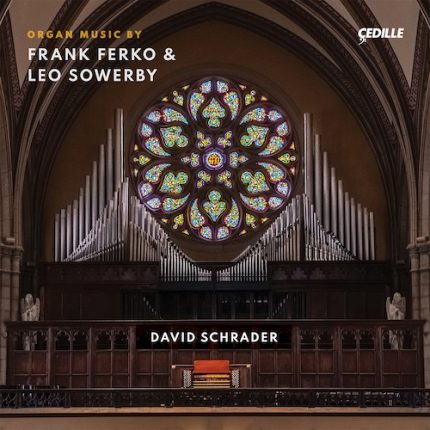Organ music by two Chicago composers, past and present, given excellent advocacy

Organ music by Frank Ferko and Leo Sowerby. David Schrader, organist (Cedille, two CDs).
At first glance, American composers Frank Ferko (born in 1950) and Leo Sowerby (1895-1968) make rather strange bedfellows on this double-CD set, given their stylistic dissimilarities. But first glances can be deceiving. In fact, both Ferko and Sowerby lived and worked in Chicago, and both added significantly to the mid-20th-century and (in the case of Ferko) contemporary organ and choral repertoire.
David Schrader, an active presence as organist and keyboardist on the Chicago music scene for decades, has long championed works by both composers. His virtuosic readings on this new Cedille album make a strong argument for their wider circulation on concert programs.
The Michigan-born Sowerby’s influence on the musical life of his adopted city was profound. For more than three decades, he taught composition at the American Conservatory of Music, while serving as organist and chorus master at Episcopal Cathedral of St. James in downtown Chicago. His output of solo and concerted organ music—of his roughly 550 compositions, nearly 80 were composed for the instrument—has been well represented on disc.
Ferko has been not nearly as fortunate; that fact, along with the intrinsic quality of the eight Ferko pieces Schrader so capably performs here makes this new release well worth investigating all by itself.
Ferko’s musical idiom is nothing if not eclectic, drawing as it does on elements of tonal romanticism, medieval plainchant and Renaissance polyphony, with nods to the harmonic practice of Olivier Messiaen, the great French modernist composer of whom Ferko is an acknowledged disciple.
Clearly no mean organist himself, Ferko writes idiomatically, beautifully and accessibly for the instrument – indeed, he fully exploits the coloristic and timbral resources of the instruments for which he composed these eight works: The three mechanical-action organs at The House of Hope Presbyterian Church in St. Paul, Minnesota, on which these recordings were made.
Four of the pieces are in theme-and-variations form; all are first recordings.
One can easily imagine the grand, splashy final variation (No. 9) of the Variations on “Veni, Creator Spiritus” – reminiscent of the famous Widor Toccata – as a popular encore in recital programs. Equally attractive is Angels – Chaconne for Organ, with its catchy variation in tango rhythm meant to express “the exuberant joy of the angels praising Almighty,” in the words of Ferko.
Both the playful Tired Old Nun and relatively austere Mass for Dedication are based on plainchant. The former is played entirely on the pedals and includes variations in the form of a waltz, blues and boogie; the latter is a five-movement organ symphony wreathed in the glowing religiosity of Hildegard of Bingen.
The standout piece is Ferko’s Symphonie brève, written for a concert given by the composer at Chicago’s Church of St. Paul and Redeemer in 1987. A delicate and shimmering central movement is preceded by a Messiaenic Andante grounded in a “walking bass” played on the pedals, and is followed by a big chorale-finale based on motives from the opening section. The 13-minute opus is dedicated to Schrader, who has championed it frequently in concert.
The organist finds comparable success with the five Sowerby works that fill the second CD. (Cedille throws in Schrader performances of Sowerby’s Two Sketches available as additional tracks in online versions of the album.) The recordings were recorded on the resplendent, 68-rank Wicks/Howell mechanical organ of St. Ita’s Catholic Church, Chicago.
Musical fashion has passed Sowerby’s music by, generally speaking, despite the fact that his works have been highly esteemed and extensively performed in the organ world for many years.
His conservative musical inclinations ran counter to the modernism of his time and continue to make him something of a concert-hall pariah to the present day. The stereotype that has come down to us is that of a well-mannered but rather stodgy church musician. Yet much of his prolific output is unworthy of neglect—well crafted, grateful to perform, rewarding to listen to, for all its lack of blazing originality. And there are moments that show genuine depth of feeling.
There are moments like that in his interwar masterpiece, the big-boned Symphony in G Major (1930-31), with its technically demanding second movement, marked “fast and sinister.” Listen to the apparent ease with which Schrader dispatches the difficult double-pedaling, his feet at opposite ends of the pedalboard, in the rousing Passacaglia at the end.
Also worthwhile is Toccata (1941), a lively party-piece for generations of organists who came after the composer, who included it on every recital program he gave from the 1940s onward; Schrader does the showpiece proud. He also rises splendidly to the fleet-footed virtuosity of Pageant (1931), written to show off the lightning pedal technique of the famed Italian organist Fernando Germani.
Detailed liner notes by Ferko and Francis Crociata—author, Sowerby authority and longtime president of the Leo Sowerby Foundation—are models of their kind. So is Bill Maylone’s excellent audio engineering, which captures the wide spectrum of sonorities produced by the various instruments, in resonant but clear church acoustics. Each CD holds more than 79 minutes of music. Warmly recommended, particularly to collectors wishing to explore neglected byways of American instrumental music. And more Ferko, please, Cedille.
Posted in Uncategorized


